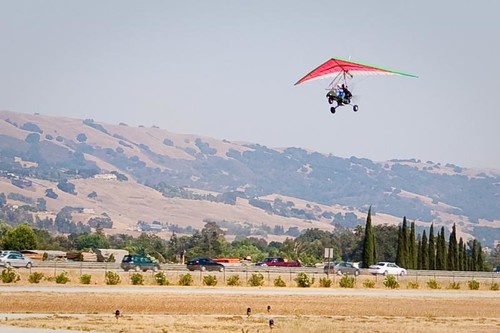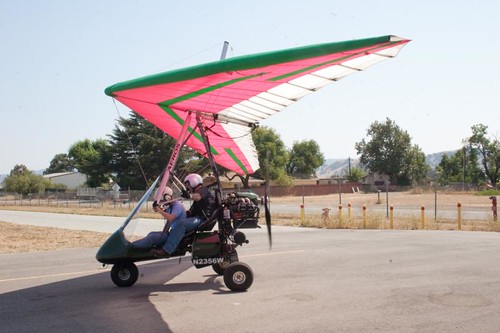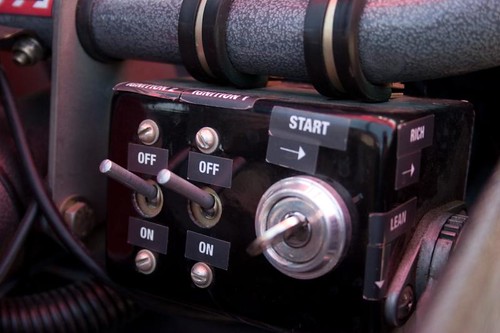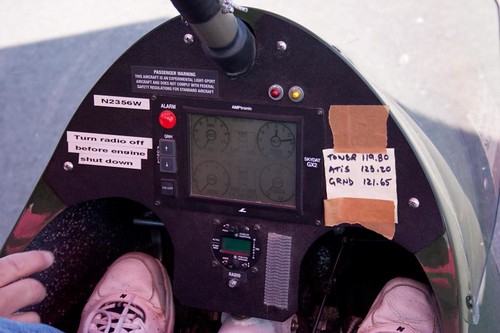My First flight in a weight-shift controlled trike
First a bit of catch-up, then on to today's story!
Several weeks ago I received an email from the FAA Air Safety website, http://faasafety.gov which regularly sends out announcements of upcoming aviation and safety related events. This one caught my eye, it was titled "Flying the wing - How to fly a Trike" and was going to be on August 1, 2009 at AreoDynamic Aviation (formerly Amelia Reid Aviation) at the Reid-Hillview Airport in San Jose.
I thought it would be interesting to check out, but kind of dismissed it until two other pilot friends of mine let me know they had interest as well, so on that day I met up with Mark and Jeff and we got to check out the Antares MA-34 R912 Ranger trike that was sitting outside of the hangar before class.
Pete Marsh was the instructor and did a good job giving a summary of weight-shift aircraft, their safety and performance, as long as talking about the fun of flying this type of aircraft. Several people had already signed up for demo flights that afternoon, and we each had other events going on that day, so none of us took him up on the offer of demo flights.
Now, to be honest, I never really liked the "look" of trikes... tubes and wires and fabric... plexiglass windshields stuck on the front, handlebars for control... they just aren't "sexy" to me... not the way an airplane should look I figured. But of course, there are major components to them that obviously did catch my attention. They are much lower cost to own and operate, they are easy to fly, and require less training than traditional aircraft.
They also bring you back to a more basic form of flight, one that I had never really had the chance to experience... being out in the wind, feeling the air change as you flew through it, feeling the wing move in your hands as you hit turbulence or thermals. And in an airplane, flying at low altitudes is one of the biggest "sins" it seems, we assume if planes get near the ground and aren't over a runway the world is probably going to end or FAA enforcement officers are going to jump out of the tree tops and take away our certificates. I knew that a bit of trike flying would re-adjust some of those views...
Well, today was the day, I gave Pete Marsh a call, talked for a bit about the details, and scheduled my flight for later in the evening. I did a short flight in my Cessna 150 that I own with a group of people at lunch, then later in the evening I headed over to South County Airport (E16) and met up with Pete.
We talked briefly about our goals for flight training, previous experience, about the seminar the previous week and a few other things. Pretty quickly he handed me a headset and a helmet and explained that I would be taking the front seat and he would hop in the back. We ran through the pre-flight, he showed me the steps to starting it up, turning on the radios, the instrument panel (a glass cockpit no less, but it was definitely no G-1000!), where the mags were located, ignition switch, and removing the parachute pin that prevents deployment on the ground.
Once we were all set, I followed the instructions I'd been given and next thing I knew I turned the key and the engine started up. From then on, it was a big step in thinking backwards... or correcting my backwards thinking, however you wish to look at it!
So it starts with steering on the ground... well, it starts even before that! So on our fixed wing aircraft we have peddles, you push the left peddle and turn left, push the right to go right. And up by our toes we have the brakes. Push both toes, you get left and right brakes turning on. You can stop evenly by pushing them together, or assist in making tight turns by using just one or the other. Well in the trike... I see peddles and toe levers... so my brain clicks, "Ahhh, this is familiar!" Oh well, it was a nice thought.
So the left peddle turns you right... right peddle turns you left. Hmmph. And the toe on the right side? That's the gas pedal. And the toe on the left? That's the brakes. At least that part is just like a car... but I'm not in a car, I'm in an airplane, so I'm not sure how much that commonality to my own ground transportation vehicle will really help me 😉
I actually got taxiing down pretty quickly for the most part, I still made mistakes and pushed the wrong peddle now and then, but I quickly learned to "test" all maneuvers slowly at the beginning, see how the plane would react (proving if I was actually doing it the right way or reverse) then continue with the maneuver.
We taxied out to the runway, did a quick run-up (there are magneto switches in the front and rear seat positions. Both of mine were in the on position, one of his was in the off position... it was made quite clear during the mag check and quickly remedied)

We pull out on to the runway, apply full throttle, count to four as we accelerated and then push the control bar all the way forward. Yes, I said forward... remember what I said about everything was backwards? Our climb speed was very good, I saw us approaching 1000' feet per minute and it really did seem fast with the wind in your air, the trike swinging below the wing, and looking to might right I could see right down to the cars on the freeway below us. I can see how this probably really isn't a good type of aircraft for a person who was afraid of heights... a sensation I've never had flying traditional aircraft.
As soon as we left the airport environment I had the controls and got to make my turns and get the feel for the wing. Pitch is left for trim and the wing to decide, throttle is used to go up and down. Turning is by pushing the bar to the left or right (and the opposite direction turn begins to take shape about two seconds later). One trick here is as you push it to the side, you need to somehow still sense the wing hunting for it's proper pitch attitude and let it go there, otherwise you enter a climb or descent.
The flight was amazing, we were able to ride some thermals (you could really feel them) as well as glide down a slope riding the rising wind... really did feel nice to be flying fairly quietly, with an open cockpit, and looking down and seeing all of the details on the ground.
Pete complimented my flying several times through the flight, he was surprised that a fixed wing pilot with so many hours was doing so well transitioning to weight-shift... not sure what the secret is exactly. As I explained to him on the way back, I'm aware that just like an airplane, that trike simply wants to fly straight and level... I don't have to fight it to fly... I just need to guide it a bit to where I want it to go. So in most of the flight I held it with a very loose grip... fingertips... and only when I was changing it's direction did I really have to give the bar a good push or shove, and even then, only briefly to make the change in direction, maintaining it was again a fairly light touch.
I have a lot to learn, I look forward to finishing up my 20 hours of training in order to add on weight-shift controlled trike to my existing private pilot certificate. I have a lot more to say, but I have many other days and lessons in which I can write about my experiences and insights as they come forth. My initial goal is to wrap up the 20 hours, beyond that, I might possibly continue the additional training to become a Light Sport Certified Flight Instructor (CFI) for weight-shift aircraft, and then add on the fixed wing option once we gain a light sport aircraft at the Santa Cruz Flying Club where I am on the board of directors.
I've always enjoyed teaching, and people tell me they think I would be a good teacher, so I figure this would be a great, and fairly inexpensive, option to really test that theory out. We'll see how it goes!



Leave a Reply
You must be logged in to post a comment.